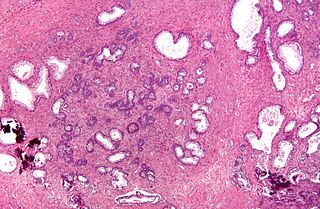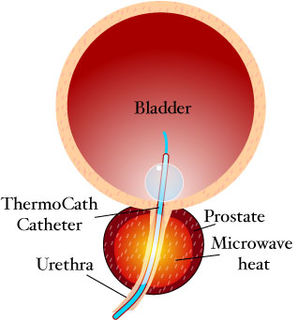Related Research Articles

The prostate is both an accessory gland of the male reproductive system and a muscle-driven mechanical switch between urination and ejaculation. It is found only in some mammals. It differs between species anatomically, chemically, and physiologically. Anatomically, the prostate is found below the bladder, with the urethra passing through it. It is described in gross anatomy as consisting of lobes and in microanatomy by zone. It is surrounded by an elastic, fibromuscular capsule and contains glandular tissue as well as connective tissue.

Transurethral resection of the prostate is a urological operation. It is used to treat benign prostatic hyperplasia (BPH). As the name indicates, it is performed by visualising the prostate through the urethra and removing tissue by electrocautery or sharp dissection. It has been the standard treatment for BPH for many years, but recently alternative, minimally invasive techniques have become available. This procedure is done with spinal or general anaesthetic. A triple lumen catheter is inserted through the urethra to irrigate and drain the bladder after the surgical procedure is complete. Outcome is considered excellent for 80–90% of BPH patients. The procedure carries minimal risk for erectile dysfunction, moderate risk for bleeding, and a large risk for retrograde ejaculation.

Prostate biopsy is a procedure in which small hollow needle-core samples are removed from a man's prostate gland to be examined for the presence of prostate cancer. It is typically performed when the result from a PSA blood test is high. It may also be considered advisable after a digital rectal exam (DRE) finds possible abnormality. PSA screening is controversial as PSA may become elevated due to non-cancerous conditions such as benign prostatic hyperplasia (BPH), by infection, or by manipulation of the prostate during surgery or catheterization. Additionally many prostate cancers detected by screening develop so slowly that they would not cause problems during a man's lifetime, making the complications due to treatment unnecessary.

The Gleason grading system is used to help evaluate the prognosis of men with prostate cancer using samples from a prostate biopsy. Together with other parameters, it is incorporated into a strategy of prostate cancer staging which predicts prognosis and helps guide therapy. A Gleason score is given to prostate cancer based upon its microscopic appearance. Cancers with a higher Gleason score are more aggressive and have a worse prognosis. Pathological scores range from 2 to 10, with higher numbers indicating greater risks and higher mortality. The system is widely accepted and used for clinical decision making even as it is recognised that certain biomarkers, like ACP1 expression, might yield higher predictive value for future disease course.
Prostate cancer screening is the screening process used to detect undiagnosed prostate cancer in men without signs or symptoms. When abnormal prostate tissue or cancer is found early, it may be easier to treat and cure, but it is unclear if early detection reduces mortality rates.
Transurethral needle ablation is a technique that uses low energy radio frequency delivered through two needles to ablate excess prostate tissue. A cystoscope/catheter deploys the needles toward the obstructing prostate tissue is inserted into the urethra directly through the penis under local anesthetic before the procedure begins. The energy from the probe heats the abnormal prostate tissue without damaging the urethra. The resulting scar tissue later atrophies, reducing the size of the prostate which in turn reduces the constriction of the urethra. It can be done with a local anesthetic on an outpatient basis. It takes about an hour to perform the procedure. It takes about 30 days for the ablated prostate tissue to resorb.
Stereotactic biopsy, also known as stereotactic core biopsy, is a biopsy procedure that uses a computer and imaging performed in at least two planes to localize a target lesion in three-dimensional space and guide the removal of tissue for examination by a pathologist under a microscope. Stereotactic core biopsy makes use of the underlying principle of parallax to determine the depth or "Z-dimension" of the target lesion.

A Mammotome device is a vacuum-assisted breast biopsy (VAC) device that uses image guidance such as x-ray, ultrasound and/or MRI to perform breast biopsies. A biopsy using a Mammotome device can be done on an outpatient basis with a local anesthetic.
Transperineal biopsy is a biopsy procedure in which a sample of tissue is removed from the prostate for examination under a microscope. The sample is removed with a thin needle that is inserted through the skin of the perineum and into the prostate. Magnetic Resonance Imaging (MRI-Guided) is a technique used to perform prostate biopsy.
Transrectal biopsy is a biopsy procedure in which a sample of tissue is removed from the prostate using a thin needle that is inserted through the rectum and into the prostate. Transrectal ultrasound (TRUS) is usually used to guide the needle. The sample is examined under a microscope to see if it contains cancer.
Nerve-sparing surgery is a type of surgery that attempts to save the nerves near the tissues being removed.
Needle-localized biopsy is a procedure that uses very thin needles or guide wires to mark the location of an abnormal area of tissue so it can be surgically sampled. An imaging device such as an ultrasound probe is used to place the wire in or around the abnormal area. Needle localization is used when the doctor cannot feel the mass of abnormal tissue.
An open biopsy is a procedure in which a surgical incision (cut) is made through the skin to expose and remove tissues. The biopsy tissue is examined under a microscope by a pathologist. An open biopsy may be done in the doctor's office or hospital, and may use local anesthesia or general anesthesia. A lumpectomy to remove a breast tumor is a type of open biopsy.

Transurethral microwave thermotherapy (TUMT) is one of a number of effective and safe procedures used in the treatment of lower urinary tract symptoms caused by benign prostatic hyperplasia. It is an alternative treatment to pharmacotherapy such as alpha blockers, transurethral resection of the prostate (TURP), transurethral needle ablation of the prostate, photoselective vaporization of the prostate and prostatic removal or prostatectomy.

High-grade prostatic intraepithelial neoplasia (HGPIN) is an abnormality of prostatic glands and believed to precede the development of prostate adenocarcinoma.
Segmental resection is a surgical procedure to remove part of an organ or gland, as a sub-type of a resection, which might involve removing the whole body part. It may also be used to remove a tumor and normal tissue around it. In lung cancer surgery, segmental resection refers to removing a section of a lobe of the lung. The resection margin is the edge of the removed tissue; it is important that this shows free of cancerous cells on examination by a pathologist.
Shave biopsy is a biopsy procedure in which a skin abnormality and a thin layer of surrounding skin are removed with a small blade for examination under a microscope. Shave biopsies are not effective in treating melanomas, but can provide a reasonably safe and accurate initial diagnosis. Surgical sutures are not needed with this procedure.
Microwave thermotherapy, is a type of treatment in which body tissue is heated by microwave irradiation to damage and kill cancer cells or to make cancer cells more sensitive to the effects of radiation and certain anticancer drugs.

If medical treatment is not effective, surgery may need to be performed for benign prostatic hyperplasia.

Piflufolastat F-18, sold under the brand name Pylarify, is a radioactive diagnostic agent used for positron emission tomography (PET) imaging. It is given by intravenous injection.
References
- Transurethral biopsy entry in the public domain NCI Dictionary of Cancer Terms
![]() This article incorporates public domain material from the U.S. National Cancer Institute document: "Dictionary of Cancer Terms".
This article incorporates public domain material from the U.S. National Cancer Institute document: "Dictionary of Cancer Terms".